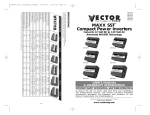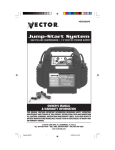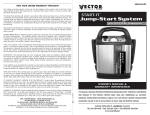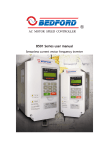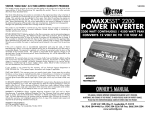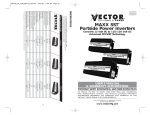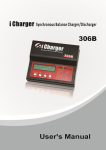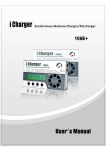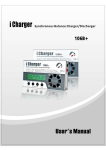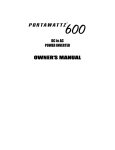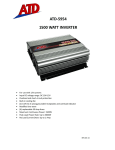Download Vector MAXX SST VEC049C Owner`s manual
Transcript
VEC049 MAXX SST 1000 TM POWER INVERTER 1000 WATT CONTINUOUS / 2000 WATT PEAK CONVERTS 12 VOLT DC TO 110 VOLT AC FRONT ADVANCED MOSFET TECHNOLOGY OWNER’S MANUAL THIS MANUAL CONTAINS IMPORTANT INFORMATION REGARDING SAFETY, OPERATION, MAINTENANCE AND STORAGE OF THIS PRODUCT. TO AVOID POSSIBLE INJURY OR PROPERTY DAMAGE, PLEASE READ THIS INSTRUCTION MANUAL CAREFULLY BEFORE USING THIS PRODUCT. © 2002 VECTOR MANUFACTURING, Ltd. 4140 S.W. 28TH WAY • FT. LAUDERDALE, FL 33312 REV.110802 4140 S.W. 28TH WAY • FT. LAUDERDALE, FL 33312 TEL 954.584.4446 • FAX 954.584.5556 TOLL-FREE: (866) 584-5504 IMPORTANT SAFETY INFORMATION To ensure reliable service, your power inverter must be installed and used properly. Please read the installation and operating instructions thoroughly prior to installation and use. Pay particular attention to the WARNING and CAUTION statements in this manual. The CAUTION statements advise against certain conditions and practices that may result in damage to your inverter. The WARNING statements identify conditions or practices that may result in personal injury. READ ALL INSTRUCTIONS BEFORE USING THIS POWER INVERTER WARNINGS TO REDUCE THE RISK OF FIRE, ELECTRIC SHOCK, EXPLOSION OR INJURY: • • • • • • Do not connect to AC distribution wiring Remove appliance plug from outlet strip or turn off inverter before working on the appliance DO NOT locate inverters in an area, room or compartment where explosive or flammable fumes might be present When using multiple outlet power strips with switches and circuit breakers ,they only interrupt power to the “hot” receptacle terminals. The “neutral” terminals remain powered with respect to the “ground” terminals Unplug appliances when servicing This is not a toy - keep away from children CAUTIONS • NO USER-SERVICEABLE COMPONENTS INSIDE OPENING UNIT WILL VOID WARRANTY • Do not use with positive ground electrical systems (the majority of modern automobiles, RVs, trucks and boats are negative ground) Reverse polarity connection will result in a blown fuse may cause permanent damage to the inverter and will void the warranty • This inverter will not operate appliances or equipment that exceed inverters maximum rating • Grounding the Neutral will cause the inverter to shut down • Do not operate this inverter if it is wet • Do not install in engine compartment - install in a well ventilated area • Not approved for use in conjunction with medical equipment IMPORTANT CABLE INFORMATION Substantial power loss and reduced battery operating time results from inverters installed with cables that are not able to supply full power. Symptoms of low battery power can result from cables that are either excessively long or an insufficient gauge. The installer/operator should be especially aware of the requirements to maintain secure, electrical connections. Cable insulation and ampacity must be the appropriate type for the environment. If you want to purchase a prepared cable and fuse set contact Technical Support at (954) 584-4446 or toll-free at (866) 584-5504, extention 119. The customer is responsible for the shipping charges on all returned items. During the warranty period, Vector Manufacturing, Ltd. will be responsible for the return shipping charges. LIMITATIONS: This warranty does not cover accessories, bulbs, fuses and batteries, defects resulting from normal wear and tear (including chips, scratches, abrasions, discoloration or fading due to usage or exposure to sunlight), accidents, damage during shipping to our service facility, alterations, unauthorized use or repair, neglect, misuse, abuse, failure to follow instructions for care and maintenance, fire, flood and acts of God. If your problem is not covered by this warranty, call our Technical Support Department at (954) 584-4446 Ext. 119 or toll-free (866) 584-5504 for general repair information and charges if applicable. STATE LAW RIGHTS: This warranty gives you specific legal rights. Some states do not allow limitations on how long an implied warranty lasts or the exclusion or limitation of incidental or consequential damages, so the exclusions or imitations stated herein may not apply. This warranty gives the purchaser specific legal rights. Other rights, which vary from state to state, may apply. TO REQUEST WARRANTY SERVICE FOR THIS PRODUCT: Contact Vector Manufacturing Technical Support by telephone, fax or mail. We suggest that you keep the original packaging in case you need to ship the unit. When returning a product, include your name, address, phone number, dated sales receipt (or copy), and a description of the reason for return and product serial number. After replacing the unit, we will attempt to return it to you within four weeks. WARRANTY ACTIVATION: Please complete Warranty Activation Card and mail to Vector Manufacturing. Enter “VEC049” as Model and Power Inverter as “Product Type”. All Vector Manufacturing, Ltd. products must be registered within (30) days of purchase. To activate this warranty, mail completed form, a copy of the original sales receipt to: WARRANTY REGISTRATION VECTOR MANUFACTURING, Ltd. 4140 S.W. 28th Way; Fort Lauderdale, Florida 33312 CONTENTS 1.0 INTRODUCTION 1. Basic Tour of Inverter . . . . . . . . . . . . . . . . . . . . . . . . . . .1 1.1 Front Panel . . . . . . . . . . . . . . . . . . . . . . . . . . . . . . . . . .1 1.2 Back Panel . . . . . . . . . . . . . . . . . . . . . . . . . . . . . . . . . .2 1.2 Maxx SST 1000 Safety Features . . . . . . . . . . . . . . . . . . .3 1.3 Appliance Cautions . . . . . . . . . . . . . . . . . . . . . . . . . . . .4 2.0 INVERTER APPLICATIONS 2.1 Uninterruptible Power Supply (UPS) . . . . . . . . . . . . . . . . .5 3.0 THEORY OF OPERATION . . . . . . . . . . . . . . . . . . . . . . . . .6, 7 4.0 OPERATION 4.1 Power Requirements . . . . . . . . . . . . . . . . . . . . . . .8, 9, 10 4.2 Determining Battery Size . . . . . . . . . . . . . . . . . . . . . . . .10 4.3 Battery Operating Time . . . . . . . . . . . . . . . . . . . . . . . .11 4.4 Protective Features . . . . . . . . . . . . . . . . . . . . . . . . . . . .12 5.0 INSTALLATION 5.1 Input Power Requirements . . . . . . . . . . . . . . . . . . . . . . .13 5.2 Operating Environment . . . . . . . . . . . . . . . . . . . . . .14, 15 5.3 Installation Sequence . . . . . . . . . . . . . . . . . . . . . . . . . .15 5.4 Quick Operational Checkout . . . . . . . . . . . . . . . . . .15, 16 5.5 Permanent Installation . . . . . . . . . . . . . . . . . . . . . . . . . .16 5.5.1 Preparation for Permanent Installation . . . . . . .16, 17 5.5.2 Permanent Installation Procedures . . . . . . . . . .18, 19 6.0 SPECIFICATIONS . . . . . . . . . . . . . . . . . . . . . . . . . . . . . . . .19 7.0 SERVICE AND REPLACEMENT PARTS . . . . . . . . . . . . . . . . . .19 8.0 TROUBLESHOOTING 8.1 Common Problems . . . . . . . . . . . . . . . . . . . . . . . . . . . .20 8.2 Troubleshooting Guide . . . . . . . . . . . . . . . . . . . . . . . . .21 9.0 MAINTENANCE . . . . . . . . . . . . . . . . . . . . . . . . . . . . . . . .22 10.0 WARRANTIES . . . . . . . . . . . . . . . . . . . . . . . . . . . . . . .22, 23 23 1.0 INTRODUCTION Your new Vector MAXX SST 1000 inverter is one in a series of the most advanced DC to AC inverters available. With proper care and appropriate usage, it will give you years of dependable service in your car, truck, RV or boat. The MAXX SST 1000 supplies 1000 watts of continuous power, with a 2000 watt peak, in the form of three household-type outlets that are ready to deliver 110 volt AC power whenever and wherever you need it! The heavy-duty inverter has enough power to run most household or electronic appliances. Added safety features include automatic shutdown and a low battery alarm to prevent damage to your battery. This Power Inverter is configured with the latest Soft Start Technology (SST). Before introduction of Soft-Start, high startup currents from large inductive loads could shut down the inverter. Soft Start improves inverter operation. Three major features incorporated in SST include: First, gradual voltage ramp-up during inverter startup. This eliminates failed cold starts under load. Second, output that momentarily dips in voltage and quickly recovers to allow large motorized loads to start. This eliminates almost all shutdowns from momentary overloads. This power inverter also incorporates a new cooling technology that directly benefits our customers. The new design more efficiently cools the power transistors, and combined with Soft Start, dramatically increases reliability and the life of the product. 1.1 BASIC TOUR OF THE MAXX SST™ 1000 MODEL INVERTER AC power is supplied via three standard North American grounded, household-type receptacles (U-ground) as shown in FIGURE 1. This allows the connection and operation of most 110 VAC-powered electrical and electronic appliances that use a standard plug. The rest of the front panel items are: One combined over-temperature and overload LED. If this lights, the inverter will automatically shut down. One green LED that lights when the inverter is operating. One ON/OFF switch that shuts off the AC output and all inverter functions. The ON/OFF switch is also used to reset the inverter after shut down due to overload or over-temperature condition. FIGURE 2 shows the back panel DC connectors and fan locations. Note that the fan only operates when the inverter’s load requires it to operate. It shuts off when cooling is not required. 1 9.0 MAINTENANCE The inverters require minimal maintenance. However, for optimum performance, perform the following as required. 1. Turn off the inverter using the front panel on/off switch. 2. Disconnect the inverter by removing the DC power fuse. 3. Check and tighten all electrical connections including the ground. 4. Using a non-metallic vacuum cleaner hose, vacuum the fan area and other air slots. 5. Clean any dirt and dust from the outside of the unit with a damp cloth. 6. Reconnect the fuse and resume operation 10. WARRANTY VECTOR 2 YEAR LIMITED WARRANTY PROGRAM This limited warranty program is the only one that applies to this product, and it sets forth all the responsibilities of Vector Manufacturing, Ltd., regarding this product. There is no other warranty other than those described herein. This Vector Manufacturing, Ltd. product is warranted, to the original purchaser only, to be free of defects in materials and workmanship for two years from the date of purchase without additional charge. The warranty does not extend to subsequent purchasers or users. Vector Manufacturing, Ltd. will not be responsible for any amount of damage in excess of the retail purchase price of the product under any circumstances. Incidental and consequential damages are specifically excluded from coverage under this warranty. This product is not intended for commercial use. This warranty does not apply to accessories or damage to units from misuse or incorrect installation. Misuse includes wiring or connecting to improper polarity power sources. RETURN/REPAIR POLICY: Defective products, other than accessories, may be returned postage prepaid to Vector Manufacturing. Any defective product, other than accessories, that is returned to Vector Manufacturing within 30 days of the date of purchase will be replaced free of charge. If such a product is returned more than 30 days but less than two years from the purchase date, Vector Manufacturing will repair the unit or, at its option, replace it free of charge. If the unit is repaired, new or reconditioned replacement parts may be used, at Vector Manufacturing’s option. A unit may be replaced with a new or reconditioned unit of the same or comparable design. The repaired or replaced unit will then be warranted under the terms of the remainder of the warranty period. 22 8.2 TROUBLESHOOTING GUIDE FIGURE 1 – FRONT PANEL TROUBLE/ INDICATION POSSIBLE CAUSE No AC output – red LED lit DC input below 10 Volts Recharge or replace battery SUGGESTED REMEDY No AC output – red LED lit Excessive appliance load-thermal shutdown Low battery alarm sounds continuously Bad connection or wiring Tighten all DC connections Low battery alarm sounds Low battery voltage Recharge battery Remove load from inverter while recharging battery Motorized power tool won’t start Excessive start-up load Rock the On/Off switch several times. If appliance does not start, then appliance will not work with inverter Motorized power tool does not operate at correct speed Purely inductive load Make the load not purely inductive. Operate an incandescent lamp at same time as motor Television/Radio interference Snow in picture, buzz in speaker Keep inverter and antenna distant from each other. Use shielded antenna cable. Connect antenna to amplifier and ground inverter case 2 3 Reduce load-wait for inverter to cool. Turn Off 4 1) THREE 1 NORTH AMERICAN STANDARD OUTLETS 2) GREEN LED SHOWS UNIT IS OPERATING 3) RED LED SHOWS UNIT IS SHUT DOWN 4) ON/OFF SWITCH FIGURE 2 – BACK PANEL 2 1 3 1) DUAL HIGH SPEED COOLING FANS 4 2) BLACK NEGATIVE (–) TERMINAL AND RETAINING NUT 3) RED POSITIVE (+) TERMINAL AND RETAINING NUT 4) TERMINAL COVER 21 2 1.2 MAXX SST 1000 SAFETY FEATURES BUILT-IN SAFETY FEATURES INCLUDE: • Automatic overload and over-temperature shutdown activated if AC output exceeds 1000 watts. • Automatic AC short-circuit shutdown and automatic reset • Automatic low voltage audible alarm and reset (sounds at 10.6 volts input) • Automatic low-voltage shutdown and automatic reset (activates at 10.0 volts DC) • Automatic high-input voltage shutdown (activates at above 14.7 volts DC) and automatic reset WARNING: MAXXSST™ 1000 output should be treated with the same caution as any 110 volt AC circuit. It is very important that anyone who is installing or using the inverter read and follow all instructions provided in this manual to ensure optimum safety and performance. MAXX SST™ 1000 inverters are ideal for powering: • TV/VCR combinations • Refrigerator/Freezers • Lights • Radio receivers/Transceivers • Heavy duty power tools & chargers • Stereo systems • Microwave ovens • Household appliances • Computers and peripheral equipment • Dry and/or wet-and-dry vacuums • Sump pumps, motors and other electric-powered equipment • Air compressors and much more MAXX SST™ 1000 Models use a 12 VDC power source like those found in 12 VDC motor vehicles or it can be operated using multiple battery configurations with commercial battery chargers or solar battery chargers. For most heavy-duty applications, a multiple battery configuration and the use of deep-cycle batteries is a requirement. With installations using multiple batteries, inverters can be operated from one of the vehicle 12 volt batteries, so there’s always one battery with adequate charge to start an engine. Other features include a high-surge capability (up to 2,000 watts), which is required to start heavy loads such as motors and other inductive devices. 3 8.0 TROUBLESHOOTING 8.1 COMMON PROBLEMS: POWER TOOLS AND MICROWAVE OVENS WON’T START Read the information panel on each power tool carefully to accurately determine the tool’s input wattage. The wattage output is sufficient to operate most power tools and microwave ovens but remember that the power needed to start the power tool may be as much as 2 to 6 times its continuous wattage requirements. "BUZZING" SOUND IN AUDIO SYSTEMS AND/OR SNOW IN TVS Inverters are shielded to minimize interference with TV signals. Ensure that the TV antenna provides an adequate "snow free" signal and that the antenna cable is high quality and shielded without the inverter operating. The problem may not be with the inverter. However, in some cases, some interference may be visible, particularly with weak TV signals. Try the following corrective measures: • Position the TV and antenna further away from the inverter if it is the cause of interference.. Adjust the antenna, or use commercial cable hookup (if possible) for best results • Do not operate high-power appliances or tools when you are watching TV • Make sure inverter's case is properly grounded as described in section 5.5.2 item 16 INVERTER SHUTS DOWN OR BATTERY FUSE OPENS Inverter will continuously deliver 12 watt or up to 10.8 amps of AC power for approximately 3 minutes and will deliver up to 2000 watt peak. After which, the inverter may shut itself down or the battery fuse will open due to overload or excessive load demand on start-up. Replace battery fuse, if opened. Reduce the load on the inverter to its maximum rated output power. Allow the inverter to cool for at least 15 minutes before attempting to start or run a high current draw device. 20 17. Check to ensure that all electrical connections are tight. 18. Ensure that the inverter’s ON/OFF switch is OFF. 19. Insert the fuse into the fuse holder. There may be some sparking. 20. Turn ON the inverter and apply a test load to the AC outlets. 21. Check all connections and tighten any loose connections. 22. Ensure that the battery has an adequate charge. If voltage is low, the cables may be too long or the gauge too light. 23. If steps 21 and 22 do not correct the problem, contact Vector Technical Support Department (954) 584-4446 Ext. 119 for professional direction. 6.0 SPECIFICATIONS Maximum Continuous Power . . . . . . . . . . .1000 Watts Surge Capacity (Peak Power) . . . . . . . . . . .2000 Watts No Load Current Draw (switch on) . . . . . . .0.6 amperes Max. Efficiency . . . . . . . . . . . . . . Approximately 90% Input Voltage . . . . . . . . . . . . . . . . . . .10.5–14.7 VDC Output Voltage . . . . . . . . . . . . . . . . .110 VAC 60 Hz Low Voltage Alarm . . . . . . . . . . . . . . . . . . .10.6 Volts Low Voltage Shutdown . . . . . . . . .10.0 Volts Auto Reset Thermal Shutdown . . . . . . . . . . . . . . . . . . .Auto Reset Wave Form . . . . . . . . . . .Modified Sine Wave (MSW) Output Receptacles . . . . . . . . . . . . . . .Three U-ground . . . . . . . . . . . . . . . . . . . . .North American standard Power Transistor Type . . . . . . . . . . . .Siemens MOSFET Weight . . . . . . . . . . . . . . . . . . . . . .9.26 lbs. (4.2 kg) Length . . . . . . . . . . . . . . . . . . . .16.14 in. (37.0 cm) Width . . . . . . . . . . . . . . . . . . . . . . . .9.5 in. (24 cm) Height . . . . . . . . . . . . . . . . . . . . . . . . .3.3 in. (8 cm) 1.3 APPLIANCE CAUTIONS DO NOT plug small appliances into the inverter receptacles to directly recharge their nickel-cadmium batteries. Always use the recharger provided with that appliance. DO NOT plug in battery chargers for cordless power tools if the charger carries a warning that dangerous voltages are present at the battery terminals. Not all fluorescent lamps operate properly with this type of inverter. If the bulb appears to be too bright, or fails to light, do not use the lamp with this inverter. Some fans with synchronous motors may slightly increase in speed (RPM) when powered by the inverter. This is not harmful to the fan or to the inverter. Certain rechargers for small nickel-cadmium batteries can be damaged if plugged into the inverters. In particular, two types of appliances are susceptible to damage: • Small, battery-operated appliances such as flashlights, cordless razors and tooth brushes that can be plugged directly into an AC receptacle to recharge • Certain battery chargers for battery packs that are used in some cordless hand-tools. Chargers for these tools have a warning label stating that dangerous voltages are present at the battery terminals DO NOT use inverters with the above two types of equipment. The majority of portable appliances do not have this problem. Most portable appliances use separate transformers or chargers that plug into AC receptacles to supply a low-voltage DC or AC output to the appliance. If the appliance label states that the charger or adapter produces a low-voltage DC or AC output (30 volts or less), there should be no problem powering that charger or adapter. 7.0 SERVICE & PARTS For service on the inverters, contact the Technical Support Department at: Vector™ Manufacturing, Ltd 4140 S.W. 28th Way • Ft. Lauderdale, Florida 33312 Tel. (954) 584-4446 Ext. 119 • Fax (954) 584-5556 • Toll-free: (866) 584-5504 19 4 2.0 INVERTER APPLICATIONS Aside from issues of supplying power to higher wattage appliances, inverters must be supplied with a constant source of high current12 volt DC from a bank of batteries. At full 1000 watt load, the DC input requirements are up to 100 amperes at 12 volts DC. Read the following applications and comply with them, and your inverter will give you years of reliable service. WARNING: Never connect the inverter’s AC output to an AC distribution system. 2.1 UNINTERRUPTIBLE POWER SUPPLY (UPS) Inverters can be operated as uninterruptible power supplies that continuously provide AC even if outside AC is interrupted. This type of application continuously operates the inverter from a battery bank, simultaneously replacing the charge on the battery bank with an AC-powered 12 Volt battery charger. Charging can also be by means of a solar charger system. See FIGURE 3. The charger must be selected to operate continuously and to be able to fully replace the charge on the battery as the inverter operates. In this configuration, the battery "floats" on the DC from the charger, not really supplying power or being charged. When outside AC fails, the inverter continues to power the appliances for the life of the useful charge on the battery bank. When outside AC is restored, the batteries are recharged as the inverter continues to operate. Battery recharging must be sized to replace the average current supplied by the inverter plus a little more current. Another requirement is that the battery charging rate cannot exceed 10% of the rated Ampere Hour (AH) rating of the battery bank, otherwise the life of the batteries can be dramatically reduced through overcharging. Most modern battery chargers automatically adjust the charging rate based on the state of charge on the batteries they are charging. For this type of operation, use deep-cycle batteries and avoid charging at too fast a rate. 12 VOLT BATTERY CHARGER UNRELIABLE EXTERNAL AC SOURCE 12 VOLT BANK OF BATTERIES MAXX 1000 POWER INVERTER THREE AC OUTLETS Figure 3 – Uninterruptible Power Supply 5 LIGHTS, TV ETC. This procedure is for using locally purchased supplies. Make appropriate changes to procedure if Vector Cable Set is purchased . 5.5.2 PERMANENT INSTALLATION PROCEDURES The cables between the power source and the inverter should be as shown in FIGURE 7. Be sure to remove terminal cover and terminal nuts before starting permanent installation. Inverter DC cables and fuse installation is as follows: 1. Using tools and hardware, mount the inverter to the flat surface that you have selected . 2. Mount the fuse holder to its mounting surface using appropriate hardware. Ensure that the mounting hardware does not touch any of the fuse holder contacts or fuse contacts. Ensure that the fuse is removed from its holder. 3. Measure the cable twice before marking the cable for cutting. 4. Cut one cable length to fit between the negative (–) connection power source and the inverter’s negative terminal, leaving a little slack in the cable. 5. Cut the remaining length of cable to be able to connect from the positive (+) battery terminal to one side of the fuse holder, leaving a little slack. 6. Cut the remaining length of cable to connect the other side of the fuse holder to the positive (+) terminal on the back panel of the inverter. 7. Strip the insulation to 1-inch (2.45 cm) from the ends of each of the three cables. 8. Crimp on or, sweat-solder the copper strands at the ends of the appropriate cables to ring terminals. For safety reasons, do this in an open space because it may require the use of a propane torch. 9. Crimp or clamp on a heavy-duty, battery-connection terminal to the other end of the negative (–) and positive (+) cable. Connect the negative (–) cable battery terminal to the negative (–) battery terminal connector. 10. Ensure that the inverter power switch is in the OFF position (SEE FIGURE 1). 11. Connect the ring terminal end of the negative (–) cable into the black stud marked (–) on the inverter back panel and tighten the retaining nut on this terminal. 12. Connect the battery connector to the negative (–) battery terminal. 13. Connect the ring terminal end of the positive (+) cable into the red stud marked (+) on the inverter’s back panel (See FIGURE 2) and tighten the retaining nut on the terminal. 14. Connect the other end of the (+) positive cable to one terminal of the heavy-duty fuse holder. 15. Connect the other conductor of the heavy-duty fuse holder to the positive (+) battery terminal. 16. Connect an insulated wire (at least #12 AWG) between the grounding screw on the inverter’s case and a solid electrical ground to minimize possible electrical noise generation in TVs and radios. Also connect a grounding wire to the terminal attached to the inverter’s enclosure. Do NOT connect this wire to the negative DC input terminal. 18 The inverter can be operated in any position, however, if it is to be mounted on a wall, mount it horizontally so that indicators, switches, outlets and terminal blocks located on the front panel are visible and accessible. If inverter is to be installed in a moving vehicle, Vector strongly recommends that the inverter be shock-mounted either on the floor (in a clear, safe area) or on a secure flat surface. Look for a convenient place to mount inverter and the fuse holder. Take the length of cable and do a trial routing of the cable. Don’t do any cutting at this time. Take a look at FIGURE 7. Measure the cable path and ensure that either the positive cable run to the battery or negative cable run to the battery does not exceed 4 feet. Using #4 AWG reposition the inverter and fuse holder if necessary. Remember and observe the other environmental requirements described earlier. After you have selected an appropriate location for the inverter and fuse block, proceed with the actual installation of the inverter. Contact Vector™ Manufacturing for any further installation information or questions. You can purchase fuses, fuse holders, #4 AWG cable or cable battery connectors from your local electrical supplier or call Vector Technical Support at (954) 584-4446 Ext. 119 for advice. Common unattended applications for the UPS (floating battery) configurations are for powering: sump pumps, safety lighting, communications equipment, burglar alarm systems and computer systems. 3.0 THEORY OF OPERATION MAXX SST™ inverters change 12 VDC into 110 VAC (110 VAC RMS), electrical power. This is accomplished in two steps. See FIGURE 4. The first stage raises the 12 VDC input to 145 VDC. The advanced design of the DC-to-DC first stage uses modern high-frequency conversion techniques that replace bulky and heavy transformers found in older, less technologically-advanced inverters. The output stage changes the 145-VDC to 110 VAC. This solid-state circuitry ensures excellent overload protection and the ability to operate reactive loads such as those found in inductive motors and most fluorescent lamps. The inverter’s output stage uses multiple banks of metal-oxide semiconductor field-effect transistors (MOSFETS). This stage functions as a high-power bipolar switch, alternately applying opposite polarity to the AC outlet HOT and NEUTRAL terminals. 100 AMP TERMINAL BLOCK #4 AWG WIRE + 145 VDO – INTERNAL WARNINGS & PROTECTION CIRCUITS 200 AMP FUSE #4 AWG WIRE DC to DC CONVERTER #4 AWG WIRE + – VOLT, AMP METERS* OVER TEMP & VOLT INDICATORS ON/OFF SWITCH 12 VOLT DC INPUT FROM BATTERY MOSFET BIPOLAR SWITCH BANKS Neutral Hot VEC049 THREE OUTLETS Ground NOTE: Cables, Fuse and Battery Are Supplied By User Figure 4 Simplified Diagram • Some Models only include volt, Amp and over temp indicators. 17 6 The 110 VAC output of the inverter is in the form of a modified sine wave (MSW) as shown in FIGURE 5. This type of waveform has the same energy characteristics as the sine wave of commercial electrical power. The modified sine wave is superior to the 100% square wave output (not shown) produced by most other DC-to-AC inverters on the market. A modified sine wave, as compared to a square wave, is vital to the efficient and proper operation of certain appliances such as computers, TVs, and certain electronic equipment. Figure 5– Modified Square Wave and Sine Wave Comparison NOTE: The 110 VAC output is a modified sine wave that produces 115 V AC Voltage. Because of wave-shape differences, if you measure the output of the inverter using standard digital or analog voltmeters, these instruments may not correctly read the voltage. Unless a true RMS reading voltmeter such as a "Fluke 87", "Fluke 8060A", "Beckman 4410" or "Triplet 4200" is used, the reading will be from 2 to 20 volts low. 3. Using the set of heavy-duty jumper cables, attach one red cable clamp to the (+) terminal bolt and one black cable clamp on the (–) terminal bolt. 4. Connect the clamps on the other ends of the jumper cables to the corresponding positive (+) and negative (–) terminals on the12-volt DC vehicle battery. There may be some minor sparking observed. 5. Turn the inverter power switch ON. 6. Plug in a lamp with a 100-watt light bulb and switch the lamp ON. If the lamp works normally, the inverter is functioning properly and you can proceed to a permanent installation or continue to use the inverter with low wattage appliances. If the lamp does not light or does not work correctly: A. Check all connections and tighten any loose connections. B. Ensure that the source battery has adequate charge. C. If steps A through B do not correct the problem, contact Vector Customer Service Department (954) 584-4446 ext. 119 for professional direction. NOTE: Any appliance or tool used for this type of test or emergency operation must be designed for 110 VAC (115-VAC RMS), 60-Hertz (Hz) and have a power consumption of 600 watts or less. The jumper cables are not designed for operating the inverter at full power. They are too long and the voltage drop is excessive. 5.5 PERMANENT INSTALLATION 5.5.1 PREPARATION FOR PERMANENT INSTALLATION For permanent installation to heavy-duty battery power you will need: • Ring terminals to fit cable ends and stud terminals • Hardware to connect two #4 AWG cables to the battery bank • A single length of not more than four feet of #4 AWG multi-stranded, flexible, insulated cable • A 200 ampere low voltage fuse holder and fuse (slow blow type or use an ANL-200) fuse and appropriate fuse holder • Mounting screws, bolts and nuts for mounting the inverter and the fuse holder • Tools to drill holes for mounting the inverter and fuse holder • Lead-tin solder, flux, propane torch and an igniter for the torch • Sharp utility knife to cut insulation and wire • Battery connector for #4 AWG cable for connection to battery or batteries • For permanent installation over four feet use the following gauge wire, #1 AWG 10 feet, #2 AWG 8 feet, #3 AWG 6 feet INSTALLATION NOTES: The inverter has four slots in its mounting bracket that allow the unit to be fastened against a bulkhead, floor, wall or other flat surface. Ideally, the mounting surface should be cool to the touch. It is more electrically efficient to use longer AC wiring than DC wiring, so install the inverter as close as possible to the 12 VDC power source. 7 16 CAUTIONS: 4.0 OPERATION This device supplies 110 VAC electrical power directly to the appliances through three standard, North American U-ground receptacles. NEVER try to use the inverters with any 12-VDC-power source that uses a positive ground. Most modern vehicles, boats and aircraft use negative ground systems. Do not connect the ground wire from the inverter to the DC negative input. • CHECK to ensure that the combined loads of the appliances being powered by the the inverters do NOT continuously exceed 1000 watts • NEVER place items on or over the inverter during operation MAXX SST™ inverters generate heat during operation like any high power device and they must be placed where cooling air can be drawn into the unit by its internal fan and heated air can be expelled and dissipated. For optimum operation, the inverter should be placed or mounted on a flat surface; ideally, a normally cool metal surface to help diffuse the heat that is generated. Two cables rated #4 AWG (as specified earlier) will be required (not supplied) each should be no longer than 4-feet long to allow for full power operation and to provide flexibility in positioning the inverter. For safety reasons, keep small children away from the inverter at all times. NOTE: Ensure that the total continuous power consumption of all tools and/or appliances connected to the inverter (and in use) does not exceed 1000 watts. Also ensure that the start-up wattage for inductive loads does not exceed 2,000 watts for more than a few seconds. 5.3 INSTALLATION SEQUENCE To wire the inverter to a 12 VDC power source, observe the following cautions, and follow the installation sequence for Quick Operational Checkout and Permanent Installation. CAUTIONS: Ensure that DC connection polarity is correct. Reversed polarity will blow a fuse and may cause permanent damage to the inverter. The manufacturer’s warranty does NOT cover damage due to reversed polarity. Review Figure 2, if necessary, to identify the location of the DC terminals, CAUTION: Appliances such as microwave ovens will normally draw more current than they are rated and could possibly overload the inverter when operating simultaneously with other appliances. For example: A 600 watt microwave oven draws approximately 940 watts. 4.1 POWER REQUIREMENTS: Most electrical tools, appliances and audio/video equipment have labels that show the unit’s power consumption in amps or in watts or both. To avoid inverter shutdown and possible damage to the inverter, take care to avoid exceeding the 1000-watt rating of this unit. If the power consumption of the tool or device is rated in amps, multiply the amps by 110 VAC to determine the wattage. For instance, a power tool rated at 4-amps will draw 460 watts. The inverter has built-in overload protection so that if you do exceed the 1000watt continuous duty limit, the inverter will automatically shut down. Once the excessive load is removed, the inverter can be restarted and resume normal operation. Note: To restart the inverter turn it OFF, and then turn it back ON to restart. The ON/OFF switch is located on the front panel of the inverter. The inverter powers resistive loads the easiest; however, larger resistive loads such as electric stoves or heaters could draw more wattage than the inverter can deliver on a continuous basis. The following chart shows the approximate amperage at 110 VAC and the corresponding wattage at 110 VAC for various common tools and appliances. APPLIANCE 5.4 QUICK OPERATIONAL CHECKOUT OR EMERGENCY USE YOU WILL REQUIRE: • One heavy-duty jumper cable set with wire rated at 4AWG • One fully-charged automobile battery • A common, slip joint pliers for loosening and tightening terminal nuts CHECKOUT PROCEDURE: 1. Remove the plastic terminal cover and terminal nuts.. 2. Identify the Positive and negative terminals on the 12 volt DC battery and identify the positive and negative terminals on the inverter. 15 LAPTOP COMPUTER HOUSEHOLD POWER MIXER 240-WATT STEREO/AMPLIFIER REFRIGERATOR 3/8" VARIABLE SPEED DRILL VARIABLE SPEED JIG SAW 10-SPEED BLENDER BELT SANDER 3/8" REVERSIBLE DRILL HOUSEHOLD FOOD PROCESSOR AMPS@ 110VAC 0.5 2 2.2 3 3 3 3.2 3.4 3.5 3.6 WATTS@ 110VAC 55 240 265 360 360 360 375 410 420 430 8 APPLIANCE COMPUTER AND MONITOR PORTABLE VACUUM 8-CUP COFFEE MAKER ELECTRIC TRIMMER 1/2" HAMMER-DRILL RECIPROCATING SAW VACUUM CLEANER 1-1/8" ROTARY HAMMER 1/6 H.P. SUBMERSIBLE SUMP PUMP COMPACT MICROWAVE OVEN AMPS@ 110VAC 4 4.6 5.5 5.5 5.5 6 7.2 7.8 8 8.5 WATTS@ 110VAC 450 540 650 660 660 720 865 940 960 1020 NOTE: APPLIANCE SPECIFICATIONS MAY VARY FROM BRAND TO BRAND. THIS TABLE IS OFFERED ONLY AS A GUIDE TO APPROXIMATE POWER RATINGS. CHECK APPLIANCE MANUALS OR PRODUCT LABELING FOR ACTUAL RATINGS. TO USE THE MAXIMUM OUTPUT OF 1000 WATTS, MAXX SST 1000 MODELS MUST BE CONNECTED TO A DC POWER SUPPLY CAPABLE OF PROVIDING 100 AMPS. A. Power Output The inverter will operate most AC loads within its power rating (1000 watts continuous). Some induction motors used in refrigerators, freezers, pumps and other motor-operated equipment require very high surge currents to start them. The inverter may not be able to start some of these motors even though their rated current draw is within specifications for this power inverter. If a motor refuses to start, observe the battery voltage using a DC voltmeter while trying to start the motor. If the battery voltmeter drops below 11 volts while the inverter is attempting to start the motor, this may be why the motor won’t start. Make sure that the battery connections are tight and that the battery (or batteries) is (are) fully-charged. If the connections are good and the battery is charged, but the voltage still drops below 11 volts, you may need to use a larger battery (or battery combination). 9 5.2 OPERATING ENVIRONMENT WARNINGS: DO NOT locate inverters in an area, room or compartment where explosive or flammable fumes might be present. Typically, these areas are: the engine room or engine compartment of a gasoline-powered vehicle or boat and small, closed, unvented battery compartments. In all marine applications, DO NOT install the inverter below or near the waterline and keep the inverter away from moisture or water. Use ONLY non-corrosive marine fasteners and fittings for installation. Only connect the inverter’s DC input to existing wiring (which must be approved for marine use) rated #4 AWG. For cable lengths exceeding 4 feet from inverter to batteries, call Vector Manufacturing for additional installation information. The cable, fuse holder, fuse (not supplied) can be purchased at an electrical supply company. The fuse holder and fuse are or ANL-200 fuse and appropriate fuse holder. Call Vector™ Technical Support (954) 548-4446 Ext. 119 or toll-free: (866) 584-5504. CAUTION: To avoid possible dangerous conditions, the where: inverters must be located 1. The unit is kept dry. 2. Air temperature is between 30°F (-1°C) non-condensing, and 105 degrees F (40° C). 3. At least three inches of clearance from other objects is maintained for cooling airflow. 4. The unit is not exposed to direct heat or sunlight or to explosive or flammable fumes. 5. The unit is as close to the DC power source as possible. 14 5.0 INSTALLATION The inverter will provide you with up to 1000 watts of continuous, electrical power (2000 watts peak) at 110 VAC when powered by a 12 VDC source such as is found in a vehicle or multiple battery configuration as shown in FIGURE 7. This manual does not describe all of the possible types of battery configurations, battery charging configurations and battery isolation configurations. 5.1 INPUT POWER REQUIREMENTS: To properly operate the inverter the DC power source must provide between 11.0 and 15.0 VDC and nominally at 100 Amps. This DC power source must be a well-regulated DC power supply as typically found in vehicular and deep-cycle marine batteries. The DC power source may also be two 12 volt batteries connected in parallel. On larger applications the power source may be several batteries connected in parallel as shown on FIGURE 7. BATTERY CHARGING FROM COMMERCIAL AC, ENGINE, SOLAR, ETC. – + BATTERY Fuse To Battery Length + Fuse To Inverter Length (Max of 4 Feet of #4 AWG Wire) 200 AMP FUSE HOLDER FUSE + – – + BATTERY – + BATTERY MAXX 1000 POWER INVERTER (Max of 4 Feet of #4 AWG Wire) – + BATTERY Figure 7 –Battery Wiring NOTE: Vector™ Manufacturing recommends that for typical heavy-duty uses, a ANL-200 or equivalent (capable of handling 200 amps for a few seconds) main buss fuse be added to the power source positive cable as close as possible to the power source (battery) positive terminal. The fuse amperage must be sized to allow simultaneous operation of all the AC appliances to be powered, with delay characteristics that allow for the momentary high start-up current requirements of inductive loads. Use the recommended fuse block (fuse holder) and fuse, or an electrical equivalent. For full rated output and motor start-up surge output, ensure that the installation is configured to handle the full load. Figure 7 is also used as a guide when the cables are measured for installing the inverter. Available through Vector Technical Support at (954) 584-4446 Ext. 119. 13 B. Input Voltage The inverter will operate from input voltages between 10.5 and 15 VDC. If the voltage drops below 10.6 volts, an audible low battery warning alarm will sound. The inverter will shut down if the input voltage drops below 10.5 VDC. This built-in feature protects the battery from being completely discharged. The inverter will also shut down if the input voltage exceeds 15 volts This protects the inverter against excessive input voltage. Although the inverter has built-in protection against overvoltage, it may still be damaged if the input voltage exceeds 15 volts. NOTE: Exceeding the recommended voltage limits will void the manufacturer’s warranty. Inductive loads, such as TVs and stereos, require more current to operate than do resistive loads with the same wattage rating. Induction motors, as well as some TVs, may require two to six times their rated wattage to start up. Because MAXX SST™ 1000 Model inverter have a peak power rating of 2,000 watts, many such appliances and tools may safely be operated. The equipment that needs the highest starting wattage are pumps and compressors that start under load. This equipment can be safely tested. If an overload is detected, the inverters will simply shut down until the overload situation is corrected. Use the front panel switch to turn OFF the inverter then ON to reset the inverter. CAUTION: NO USER-SERVICEABLE COMPONENTS INSIDE. OPENING UNIT WILL VOID WARRANTY. 4.2 DETERMINING BATTERY SIZE: To determine the minimum battery size that you will need to operate appliances from the MAXX SST™ 1000 Models, follow these steps: 1. Determine the wattage of each appliance and/or tool you will need to simultaneously operate from the inverter. To do this, read the labels on the equipment to be operated. Usually, power consumption is shown in watts. If it is shown in amps, multiply by 110 to determine the wattage. 2. Estimate the number of hours the equipment will be in use between battery recharges. 3. Determine the total watt-hours of energy use, the total running time and the average power consumption. To get an estimate of the current (in amps) that the battery must be capable of delivering, divide the load consumption power (in watts) by (10). Keep in mind that most appliances are not operating for long periods of time. For example, a typical home-use coffee maker draws 500 watts during it’s brew time of 5 minutes, but it maintains the temperature of the pot at about 100 watts. Typical use of a microwave is only for a few minutes, sometimes at low power. Some exceptions to brief operating times are lamps, TVs and computers. 10 4.3 BATTERY OPERATING TIME FIGURE 6 is a set of curves that show how appliance load in watts or in amperes affects operating time. These curves are only estimates of operating time, dependent upon: • The condition of the batteries • The state of charge on the batteries • The amount of other DC appliances drawing current from the batteries Three curves were developed for a battery of 50 Ampere Hours (AH) capacity, and three for multiple batteries in parallel. The higher capacity curves are for 120 AH and 200AH capacities. These large capacity batteries clearly extend operating time at full load. To extend operating time, in general, reduce the heavy appliance load to a minimum. Remember, you are operating on stored energy and probably under power loss conditions. All operating time curves assume permanent installation with the correct DC input wire (#4 AWG) and a full charge on the batteries. 4.4 PROTECTIVE FEATURES LOW BATTERY ALARM: An audible alarm will sound when: 1. The 12-VDC power supply voltage drops down to 10.6 volts. This indicates that the battery needs to be recharged or there is an excessive voltage drop between the battery power source and the inverter. NOTE: It is normal for the alarm to sound the when inverter is being connected to, or disconnected from, a 12 VDC-power source. This does NOT indicate a problem. However, if this alarm sounds continuously, except as described, discontinue inverter operation and recharge the battery before resuming operation. If the voltage drops to 10.0 VDC, the inverter will automatically shut down. If the low voltage alarm sounds when the battery is fully-charged, refer to the troubleshooting table for possible causes and remedies. CIRCUIT PROTECTION: The inverter has electronic circuit protection against overload or short circuit condition 100 10 200 20 WARNING: If turning the front panel mounted switch OFF then ON does not reset the inverter, DO NOT ATTEMPT TO OPEN THE INVERTER. Opening the inverter, for any reason, will void the warranty. The unit must be returned to Vector Manufacturing, Ltd. for testing and repair by professional factory technicians. 300 30 400 40 500 50 600 60 700 70 800 80 900 90 1000 100 15 30 45 60 75 90 105 120 135 150 165 180 195 210 235 240 Figure 6 – Battery Operating Time For example, as shown in FIGURE 6, using a 200 amp hour battery (batteries) if the average power usage will be 1000 watts the operating time will be about 150 minutes. A larger capacity battery will deliver more operating time between recharges. NOTE: The manufacturer recommends conservative estimates when selecting a battery. More amp-hours will deliver a reserve capacity and a larger capacity battery will not be subject to deep discharges. Ideally, the number of amp hours you expect to use should be less than 50% of the battery’s rated capacity. 11 12














